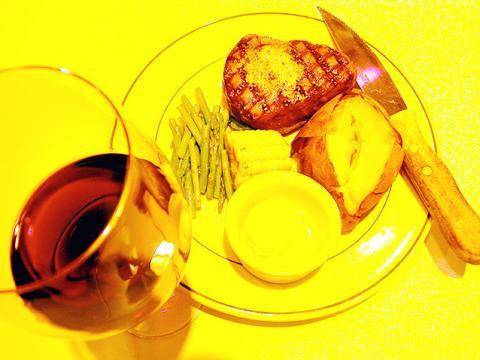There used to be a perception that the most that could be said about American food was that there was plenty of it. The legend at the end of Dan Ryan's menu seemed to corroborate this, saying, "Warning! We serve American portions."
The rest of the menu advertised the usual appetizers, caesar salads, lasagnes, ice cream and so on that seemed to reflect a fixed idea of US cooking being just a few old European staples, but bigger and topped off by steaks, baby ribs and potato skins filled with cheese and mayonnaise.
For an Asian chain of restaurants with branches on Dunhua North Road, in Hong Kong and Singapore, Dan Ryan's homage to 1930s America and its nascent cuisine could look a little tired to those in search of fresh pastures, or possibly something a little more original, like say Californian cuisine, southern or creole cooking, or even a contemporary New York diner.

PHOTO: JULES QUARTLY, TAIPEI TIMES
Instead there are yellowing ceilings, cobwebs above the train track and the marks of time on fake hangings. The soft shell crab starter (NT$320) lacked much meat, but did have acres of batter, which the wait staff suggested should be dipped vigorously in a mayonnaise and tomato sauce.
Though the C.A.B. (certified Angus beef) nine-ounce Angus (NT$820) was indeed a good piece of beef, the surrounding plate of stranded asparagus and a baked potato looked in need of cheering up. The white Cotes du Rhone (NT$200 for a glass, NT$1,050 for a bottle), to be fair, did that.
Paul Christian came up with the idea for Dan Ryans after living in Asia for 20 years and thinking to himself -- like many traveling Americans before and since -- that what everyone really wanted was good ol' western home-style cooking. To this end, Christian opened his first restaurant in 1987 and decked it out to feel like Chicago in the 1930s.
Then he named it after a black-gold politician from the city at that time to make it sound quintessentially American. He imported many of the ingredients for his dishes from the US to make the food as authentic as possible.
Clearly, the strategy has worked and is now seen repeated at Swensen's, T.G.I. Friday's, Ruth's Chris, even Hard Rock cafe. But you're not eating good ol' home cooking, what you're really getting is another franchise serving blandly identical dishes.
If this works, which it evidently does, then why change the formula? In essence, Dan Ryan's is serving up something dependable. It might not be cordon bleu, or interesting, but it is what you asked for. And this is not a bad thing, but sometimes even nostalgia needs freshening up.

Last week writer Wei Lingling (魏玲靈) unloaded a remarkably conventional pro-China column in the Wall Street Journal (“From Bush’s Rebuke to Trump’s Whisper: Navigating a Geopolitical Flashpoint,” Dec 2, 2025). Wei alleged that in a phone call, US President Donald Trump advised Japanese Prime Minister Sanae Takaichi not to provoke the People’s Republic of China (PRC) over Taiwan. Wei’s claim was categorically denied by Japanese government sources. Trump’s call to Takaichi, Wei said, was just like the moment in 2003 when former US president George Bush stood next to former Chinese premier Wen Jia-bao (溫家寶) and criticized former president Chen

As I finally slid into the warm embrace of the hot, clifftop pool, it was a serene moment of reflection. The sound of the river reflected off the cave walls, the white of our camping lights reflected off the dark, shimmering surface of the water, and I reflected on how fortunate I was to be here. After all, the beautiful walk through narrow canyons that had brought us here had been inaccessible for five years — and will be again soon. The day had started at the Huisun Forest Area (惠蓀林場), at the end of Nantou County Route 80, north and east

A six-episode, behind-the-scenes Disney+ docuseries about Taylor Swift’s Eras Tour and Rian Johnson’s third Knives Out movie, Wake Up Dead Man, are some of the new television, films, music and games headed to a device near you. Also among the streaming offerings worth your time this week: Chip and Joanna Gaines take on a big job revamping a small home in the mountains of Colorado, video gamers can skateboard through hell in Sam Eng’s Skate Story and Rob Reiner gets the band back together for Spinal Tap II: The End Continues. MOVIES ■ Rian Johnson’s third Knives Out movie, Wake Up Dead Man

Politics throughout most of the world are viewed through a left/right lens. People from outside Taiwan regularly try to understand politics here through that lens, especially those with strong personal identifications with the left or right in their home countries. It is not helpful. It both misleads and distracts. Taiwan’s politics needs to be understood on its own terms. RISE OF THE DEVELOPMENTAL STATE Arguably, both of the main parties originally leaned left-wing. The Chinese Nationalist Party (KMT) brought together radicals, dissidents and revolutionaries devoted to overthrowing their foreign Manchurian Qing overlords to establish a Chinese republic. Their leader, Sun Yat-sen